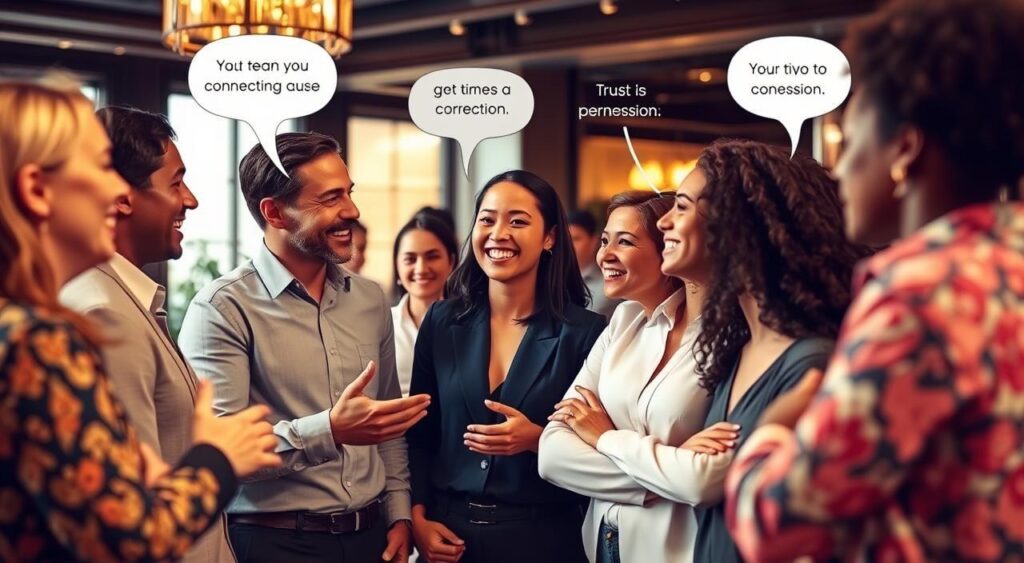In today’s competitive sales world, mastering rapport and building relationships is key. It’s not just nice to have; it’s crucial for making sales and keeping relationships strong. Using sales psychology, making a strong buyer connection can lead to success or failure.
By paying attention to body language, voice tone, and real empathy, you can make a special bond. This bond helps in getting successful sales results.
Trust is super important in selling. People tend to buy from those they feel they can trust. This is shown by the 7-38-55 rule, which points out much of our communication is non-verbal. As Quantified Impressions says, the way you deliver a message is often twice as important as the message itself. This shows how crucial your tone of voice and body language are.
The process of creating rapport and building goes beyond the first meeting. It includes follow-up talks and ongoing contact, making it more likely for people to become long-term clients. A good rapport means keeping a conversation balanced, with a talk-to-listen ratio of 43:57. This shows the value of listening well. By sticking to these ideas, you can improve your sales and create stronger bonds with buyers.
Key Takeaways
- Trust is vital for successful sales chats.
- How you say something matters more than what you say.
- Non-verbal cues play a big role in how we communicate.
- Keeping conversations balanced helps in building rapport.
- To build rapport, you need consistent and true effort.
Understanding the Importance of Rapport in Sales
Rapport in sales is about building real trust with clients, not just trying to be liked. It involves using emotional intelligence to meet each client’s unique needs. This approach lays the groundwork for a successful sale.

What is Rapport and Why It Matters
Rapport means having a close relationship where there’s mutual trust and understanding. It’s about tuning into others’ communication styles and preferences. Studies show that 70% of buyers prefer to buy from salespeople they connect with on a personal level. This connection leads to more sales because sellers better understand and meet client needs.
The Role of Trust in Buyer Connections
Trust is vital in sales relationships. Emotional intelligence lets you pick up on and react to clients’ feelings, which builds trust. Salespeople who do this well are 50% more likely to close deals. Also, 60% of sales people will say their purchase decisions are greatly influenced by their relationship with the salesperson. Trust increases referrals too, showing reliability and honesty.
The Science Behind Sales Psychology
The science of sales psychology digs deep into how we understand and sway what consumers want. Sales pros improve their impact by using key selling skills and better communication. This not only builds stronger connections but also boosts sales.
Key Principles of Sales Psychology
Top sales tactics often use key ideas from sales psychology. These include six influence principles by Dr. Robert Cialdini, like giving to receive and being a proven authority. For example, offering something first can increase sales by 48%. And making a product seem rare can drive quick buys up 50%.
The Impact of Nonverbal Communication
What we don’t say can often mean the most in sales. Studies say 93% of communication is without words, making things like eye contact crucial. The way you stand or look can build trust. Dr. Albert Mehrabian’s rule teaches that words, voice tone, and body language all play a part. So, sharp nonverbal skills can help seal the deal.

To wrap up, using sales psychology makes you a better seller. It sharpens your persuasive skills and communication. Mastering this leads to more sales, happier customers, and lasting bonds.
| Principle | Impact |
| Reciprocity | Increases sales effectiveness by 48% |
| Scarcity | Boosts urgency-driven purchases by 50% |
| Nonverbal Communication | 93% of communication is nonverbal |
| Empathy | 70% of buyers prefer empathetic salespeople |
Techniques for Building Rapport Quickly
Building rapport quickly is key to making strong connections with customers. To do this well, try active listening, body mirroring, and asking open questions. These tactics can greatly build instant rapport and improve how you interact.

Active Listening Strategies
Active listening is more than just hearing words. It’s about understanding the feelings and thoughts behind them. Research shows that using effective feedback can keep a prospect’s attention well. This is much better compared to just talking at them.
By repeating what a person says, you can show them they’re understood. This can boost rapport by a lot. Starting conversations with personal questions also helps make interactions better.
Mirroring and Matching Techniques
Mirroring someone’s actions can make them feel more at ease. Matching the same way how they talk can also help. Not doing this can make 70-80% of people feel disconnected.
Things like copying each other’s body language or speaking speed can improve your bond. Even small actions like smiling or nodding can make a big difference. These changes can make the buyer feel more connected by about 40%.
Creating a Positive First Impression
First impressions are crucial in selling, as they help build a good connection. They come from things like how we stand, how we dress, and our smiles. Using these well boosts how we communicate and understand others in sales.
The Power of Body Language
Body language is a key silent signal that affects what buyers think of you. Keeping an open stance, looking people in the eye, and moving in a lively but calm way shows you’re confident and friendly. Studies show that showing confidence this way can make customer satisfaction go up by 30%.
Establishing a Genuine Smile
A real smile is a simple but powerful way to bond with a buyer. It shows kindness and openness, helping the buyer relax. It’s worth noting that 90% of customers say being genuine makes them more likely to buy, so an honest smile is key in sales talks.

Finding Common Ground and Shared Interests
Finding common ground and shared interests is a crucial aspect of building rapport with buyers. When you discover that you have something in common with someone, it creates a sense of connection and mutual understanding. This can be a powerful way to establish rapport, as it allows you to build a relationship based on shared experiences and interests.
To find common ground and shared interests, start by asking open-ended questions that encourage the other person to share their thoughts and feelings. Listen actively and pay attention to their responses, looking for areas where you may have something in common. This could be a hobby, a favorite book or movie, or even a shared experience.
For example, if you’re talking to a buyer who loves hiking, you could ask them about their favorite hiking spots or what they enjoy most about hiking. This can lead to a conversation about shared experiences and interests, helping to establish a rapport. By finding common ground, you create a foundation for a harmonious relationship, making it easier to build trust and connect on a deeper level.
Tailoring Your Approach to Different Buyer Types
It’s key to adjust your sales approach for different buyer types. This means knowing who they are and how they think. You also need to adapt how you talk and what you offer. Such a strategy looks past just age or location. It digs into the psychology behind people buy their shopping habits, improving how you persuade them.
Understanding Buyer Personas
Buyer personas are like imaginary friends. They represent your perfect customers, built from deep research. Knowing them helps you change how you sell.
Let’s look at some common types:
- Self-esteem Seekers: 60% base their decisions on feeling confident in the seller.
- Connection Seekers: 4 times more likely to choose products based on personal rapport.
- Value Seekers: 75% require data proving ROI before making decisions.
- Significance Seekers: Often willing to pay premium prices for VIP treatment.
Adapting Communication Styles
To connect well with different buyers, sales pros must change how they talk:
- Analytical Buyers: 85% love data and facts. They check many places before buying.
- Amiable Buyers: 70% decide based on trust and like to agree with friends first.
- Driver Buyers: They’re fast, choosing quickly and valuing their time. 60% buy in less than 15 minutes.
- Expressive Buyers: 90% trust their gut and feelings more than just the facts.

Identifying Buyer Needs and Preferences
Finding out what buyers need is essential. For example,:
- Analytical Buyers: They take their time, scared of risks, and want lots of data.
- Amiable Buyers: They prefer making decisions with others and like a cozy sales chat.
- Driver Buyers: They love quick, to-the-point pitches.
- Expressive Buyers: They’re into new ideas and fun presentations.
By understanding and meeting their needs, you can sell better. This customized approach can greatly improve your results. In fact, making your sales pitch more personalized can increase your success rate by as much as 20%.
| Buyer Type | Key Characteristics | Effective Approach |
| Self-esteem Seekers | Confidence in the Seller | Reassure and Highlight Benefits |
| Connection Seekers | Personal Rapport | Build Strong Personal Relationships |
| Value Seekers | ROI Data | Provide Clear ROI Evidence |
| Significance Seekers | VIP Treatment | Offer Premium Services |
| Analytical Buyers | Data-Driven | Present Facts and Figures |
| Amiable Buyers | Trust-Based | Foster Trust, Seek Consensus |
| Driver Buyers | Efficiency | Provide Clear Next Steps |
| Expressive Buyers | Intuitive | Emphasize Creativity |
The Role of Empathy and Active Listening in Connection
Empathy is key in building strong, long-term connections with buyers. It’s not just about hearing words. It involves grasping the feelings behind them. Recognizing and responding to the emotions of buyers builds trust and understanding. These are crucial for success in sales and keeping customers loyal. Empathy helps build relationships, especially in complex sales involving multiple decision-makers, by addressing knowledge gaps and preventing competitors from gaining an advantage.

How to Practice Empathetic Listening
Empathetic listening is vital for emotional intelligence in sales.
By actively listening, sales interactions see a 35% boost in customer satisfaction. Techniques like pausing to reflect on the buyer’s words enhance engagement. Saying things like “I hear you” or “That sounds like a challenge” makes buyers feel seen. This can make the connection feel 25% stronger, creating a deeper relationship.
Responding to Emotions Appropriately
Responding well to emotions builds trust and openness.
Handling objections with empathy could improve your chances of overcoming them by 45%. Positive body language, like good eye contact, makes you seem 50% more trustworthy. Empathy in your interactions can boost customer engagement by 40%, making people feel valued.
| Metric | Impact |
| Empathy in Sales | Boosts conversion rates by 20% |
| Active Listening | Increases customer satisfaction by 35% |
| Mirroring Body Language | Improves rapport by 70% |
| Positive Body Language | Enhances trustworthiness by 50% |
| Personalization | Increases engagement by 40% |
| Empathic Sales Practices | Boosts customer satisfaction by 60% |
| Strong Rapport | Leads to 80% likelihood of repeat business |
| Small Talk | Enhances rapport by 30% |
The Law of Reciprocity in Rapport Building
The Law of Reciprocity is a fundamental principle of human behavior that states when we receive something, we feel obligated to give something back. This can be a powerful tool in building rapport with buyers, as it allows you to create a sense of mutual obligation and reciprocity.
To use the Law of Reciprocity in rapport building, try giving something of value to the other person, such as advice, information, or a favor. This can create a sense of obligation and reciprocity, helping to establish a rapport. For instance, if you’re talking to a buyer who is struggling with a problem, you could offer to help them brainstorm solutions or provide advice. This act of giving can create a sense of mutual obligation and reciprocity, fostering a stronger connection.
By leveraging the Law of Reciprocity, you can build instant rapport and develop a relationship based on mutual trust and respect. This principle is especially effective in sales, where creating a sense of give-and-take can lead to more successful and lasting buyer connections.
Building Long-Term Relationships with Buyers
Building long-term bonds with buyers is more than making a sale. It involves effective follow-up and nurturing these relationships. This means giving continuous value and understanding their changing needs.
Stay in touch regularly in meaningful ways. This helps make customers loyal and turns single sales into lasting partnerships.

Follow-Up Strategies That Work
Following up after a sale boosts how often customers come back. Sending a thank-you note can make them 34% more likely to buy again. Also, checking in regularly helps you understand and solve their problems.
Use different ways to communicate, like emails or calls. This keeps your relationship fresh and makes each buyer feel special.

Nurturing Client Relationships Over Time
To make top sales professionals keep customers long-term, manage relationships carefully. Keep offering value after the sale to build trust and loyalty. Share updates, give special deals, and ask for feedback to make your services better.
Treat every interaction as a chance to develop rapport and to strengthen your bond. Make buyers see you as a trusted advisor, not just a seller.
Creating Value Beyond the Sale
Adding value means knowing and adapting to your clients’ needs. Use resources like webinars or papers to support their success. Social proof, like case studies or reviews, also strengthens bonds by showing your worth.
Personalize these efforts to fit what each client likes. This boosts their effect and keeps loyalty strong.
| Strategy | Impact |
| Regular Follow-Ups | 60% increase in customer retention |
| Thank-You Notes | 34% more likely to lead to repeat purchases |
| Educational Resources | Improves perceived value and trust |
| Social Proof | 15-20% boost in conversions |
Developing a Rapport Building Strategy
Developing a rapport building strategy is essential for building strong relationships with buyers. This involves identifying the key elements of rapport building, such as active listening, nonverbal communication, and finding common ground, and incorporating them into your interactions.
To develop a rapport building strategy, start by identifying the key elements of rapport building that are most important to you. Incorporate these elements into your interactions with buyers. This can involve practicing active listening, paying attention to nonverbal communication, and looking for areas where you may have something in common with the other person.
For example, if you’re a sales professional, you could develop a rapport building strategy that involves using active listening to understand the needs and concerns of your clients. Use nonverbal communication to build trust and establish a rapport. By consistently applying these techniques, you can create a strategy that enhances your ability to connect with buyers and build lasting relationships.
Overcoming Barriers to Rapport
Building rapport in sales can be tough. Recognizing and overcoming common obstacles is key. We will explore strategies to connect better with buyers.
Common Challenges in Building Connections
Buyer resistance is a big hurdle. Lack of trust, bad past experiences, or skepticism can cause this. Sales Insights says 95% of buying decisions come from personal interactions.
Dealing with tough personalities requires a special way of talking to people.

Strategies to Break Down Buyer Resistance
To reduce buyer resistance, show real empathy. Creating trust happens by listening well, answering concerns, and responding well to questions. HubSpot found that good listeners in sales see a 40% higher closing rate.
Sharing personal stories can make people see you as 50% more trustworthy.
Dealing with Difficult Personalities
Adapting how we talk based on the client’s style is key. 64% of salespeople say this matches well with clients leading to better sales. Good sales communication means knowing people are different, being patient, and using body language well.
Up to 93% of good communication is about non-verbal cues. Being genuine and empathetic can make customer loyalty jump by 60%, recent studies show.
Using these methods, salespeople can get past challenges and have better talks, boosting engagement and sales.
Measuring the Success of Rapport Building
Measuring the success of rapport building is essential for evaluating the effectiveness of your rapport building strategy. This involves identifying key metrics, such as the number of new relationships established, the depth of those relationships, and the level of trust and mutual understanding.
To measure the success of rapport building, start by identifying key metrics that are relevant to your goals and objectives. Track these metrics over time. This can involve using surveys or feedback forms to gather data, or simply paying attention to the quality of your relationships with buyers.
For example, if you’re a sales professional, you could measure the success of your rapport building strategy by tracking the number of new clients you acquire, the level of trust and mutual understanding you establish with those clients, and the overall quality of your relationships with them. By paying attention to these metrics, you can evaluate the effectiveness of your rapport building efforts and make adjustments as needed to improve your results.
FAQ
What is rapport and why it matters?
Rapport is a special way of communicating that makes people feel connected. It helps in talking smoothly and liking each other more. For salespeople, it means building trust with clients. This trust makes clients want to buy.
The Role of Trust in Buyer Connections?
Trust makes buyers feel safe and connected to salespeople. Sales folks can create trust by acting like their buyers. This includes using similar gestures and talking in a way that makes a deep connection.
How does rapport influence buyer decisions?
Rapport makes buyers feel understood and comfortable. This feeling often leads them to buy things, sometimes more than what’s logical. Building rapport requires salespeople to be emotionally smart. This helps them make buyers feel valued.
What are the key principles of sales psychology?
Sales psychology is about knowing what makes buyers tick. It focuses on understanding buyers’ feelings and the unspoken parts of conversations. Salespeople use this knowledge. They try to match buyers’ moods and sell in persuasive ways that meet buyers’ expectations.
What emotional triggers drive buyers?
Buyers are moved by feelings like being understood, valued, and connected. Sales professionals tap into these feelings. They interact in caring ways and meet the emotional needs of their clients.
What is the impact of nonverbal communication in sales?
Things like gestures, the way people talk, and facial expressions matter a lot in sales. Salespeople who are good at noticing and responding to these cues can build better rapport. Their pitches become more real and effective.
What are some active listening strategies for building rapport?
Active listening means giving your full attention to the buyer. It involves showing you’re listening and understanding what they say. Doing things like nodding and keeping eye contact helps make sure you get it right. This builds trust.
How do mirroring and matching techniques help in sales?
By copying the buyer’s actions and ways of talking, salespeople can make them feel more at ease. This quickens the building of rapport and strengthens the connection. Buyers tend to relax and open up more in such situations.
How can open-ended questions engage buyers?
Asking questions that need detailed answers keeps the conversation going. It lets salespeople learn more about what the buyer wants and needs. With this info, they can make their sales pitch more appealing to the buyer’s feelings and interests.
What is the power of body language in creating a positive first impression?
The way you stand, shake hands, and smile makes a big first impression. Good body language shows you’re professional and friendly. This helps start sales meetings positively, making it easier to build trust.
How does dressing for success impact sales interactions?
Wearing the right clothes shows you’re serious and respect your clients. This helps build credibility from the start. Dressing well is part of communicating effectively, influencing how clients view and trust a salesperson.
Why is establishing rapport with a genuine smile important in sales?
A real smile makes most people feel welcome and comfortable. It’s a sign you’re friendly and open, which helps make a quick connection. This is key in starting to build rapport right away.
How can understanding buyer personas improve sales tactics?
Knowing different types of buyers helps salespeople adjust their approach. By matching their techniques to what each buyer likes, they can be more persuasive. This makes their selling strategies more effective, leading to more sales.
What strategies can help adapt communication styles to different buyers?
Adapting means speaking in a way the buyer likes best. This could mean changing your tone or how fast you talk. The goal is to make the buyer feel comfy and understood.
How can you identify buyer needs and preferences?
To learn what a buyer wants, listen closely, ask the right questions, and watch their body language. Knowing their needs lets you tailor your sales approach. This way, it fits what the buyer is looking for.
How can empathetic listening be practiced effectively?
Empathetic listening is about really hearing the buyer and caring about what they say. You can show you understand by repeating their feelings back to them. Keeping an open mind is key to this kind of listening.
Why is recognizing buyer emotions important in sales?
Understanding how a buyer feels helps you see what they truly need or worry about. Knowing this, salespeople can respond better. They create connections based on trust and care, which is good for long-lasting relationships.
How should one respond to buyers’ emotions appropriately?
The right response shows you get how the buyer feels and take their concerns seriously. Use words that show empathy and offer solutions. This strengthens your relationship with the buyer.
What are effective follow-up strategies for building long-term relationships?
Good follow-up means checking in regularly, sharing helpful info, and keeping in touch in a personal way. These actions show you’re still genuinely interested in the buyer’s success. It keeps the bond strong over time.
How can client relationships be nurtured over time?
Keeping up with clients’ changing needs and offering help shows you care. Regular, thoughtful contact is key. Trust, adding value, and keeping engaged are the foundations of lasting relationships.
How can value be created beyond the initial sale?
Adding value means giving support and sharing knowledge even after the sale. This builds a reputation for being helpful and knowledgeable. Happy clients are likely to come back and recommend you to others.
What are common challenges in building rapport?
Challenges include when buyers don’t open up, have different ways of communicating, or are tough to deal with. To overcome these, change how you talk, be patient, and make your points clear and simple.
How can you break down buyer resistance?
To get past objections, first understand why the buyer is hesitant. Show empathy and provide clear reasons why your solution works. Trust and genuine care help lessen resistance and make cooperation easier.
What strategies work in dealing with difficult personalities?
When facing tough personalities, stay calm and polite. Listen well and respect their views. Adjusting how you speak to fit their style can ease tensions and help in building a connection.
What key performance indicators (KPIs) should be tracked to measure rapport-building success?
Watching things like how many sales happen, how satisfied customers are, and if they buy again can tell you a lot. These numbers show how well your rapport-building is working. They help you make it even better.
How can feedback from buyers be solicited effectively?
Asking for feedback through surveys, talks, or emails is good. Focus on what their experience was like and how it can be better. This shows you value their opinion, which can give you great ideas for improvements.
What are continuous improvement strategies for your rapport building questions and-building techniques?
Keep looking at feedback, stay up-to-date on sales methods, and change your approach based on what buyers want. Always trying to get better makes sure your way of building rapport stays effective.
References
- Building Rapport: 10 Best Ways to Instantly Build Trust in Sales – https://www.yesware.com/blog/building-rapport/
- A Practical Guide On Building Rapport In Sales – Head Of Sales – https://www.headofsales.com.au/sales-psychology/buyer-behaviour/building-rapport-in-sales-guide/
- Sales Psychology: The secret of instant rapport | Peter Shallard – https://www.petershallard.com/sales-psychology-instant-rapport/
- The Ultimate Guide to Rapport Building With Buyers – https://sbigrowth.com/insights/blog/guide-to-building-relationships-with-your-buyers
- The Psychology of Sales: Uncover Buyer Behaviors to Win More Deals – https://www.yesware.com/blog/psychology-of-sales/
- The Psychology of Sales: Unlocking Your Potential – https://medium.com/@colin-cooper/the-psychology-of-sales-unlocking-your-potential-6d47e128450c
- The Psychology of Selling: Understanding the Science Behind Persuasion – https://www.insidesalesexpert.com/blog/The-Psychology-of-Selling-Understanding-the-Science-Behind-Persuasion
- Building Rapport Fast | 6 Scientifically Proven Selling Steps – https://salesinsightslab.com/building-rapport-in-sales/
- Top 10 Techniques to Build Quick Rapport with Anyone – https://glginsights.com/articles/top-10-techniques-to-build-quick-rapport-with-anyone/
- Adapting Your Sales Approach for Different Prospect Personalities – https://blog.thecenterforsalesstrategy.com/adapting-sales-approach-for-prospect-personalities
- Sales Psychology Secrets: How to Win Every Customer | Alore – https://www.alore.io/blog/sales-psychology
- What is customer rapport? (+8 ways to build it) – https://www.zendesk.com/blog/customer-rapport/
- The Power of Mirroring: Build Rapport and Close More Sales | Mailchimp – https://mailchimp.com/resources/mirroring-in-sales/
- Sales Sense Shot #2: Unlocking Buyer Psychology — 4 Types You Must Master to Win in Sales – https://www.linkedin.com/pulse/sales-sense-shot-2-unlocking-buyer-psychology-4-types-alejandro-1pzoc
- How to Sell to Different Buyer Types – https://www.thequota.co/articles/how-to-sell-to-different-buyer-types
- Buyer Psychology: Alarming Info In Face-To-Face Sales – https://www.iangenius.co.uk/understanding-buyer-psychology/
- The Art of Connection: Rapport Building Techniques for Sales Professionals – Blue Monarch Group – https://bluemonarchgroup.com/blog/the-art-of-connection-rapport-building-techniques-for-sales-professionals/
- The Irresistible Allure of Empathy in Sales Psychology – Sigstr – https://terminus.com/sales-psychology-empathy/
- All You Need To Know About Sales Psychology To Grow Revenue — Dopplio – https://www.dopplio.com/blog/sales-psychology
- The Psychology of Selling – EXELA – https://exela.co.uk/the-psychology-of-selling/
- 7 Easy Ways to Build Rapport in Sales and Earn Trust of Your Prospects and Clients – https://zixflow.com/blog/building-rapport-in-sales
- How to Build Rapport in Sales – https://www.trevorambrose.com/how-to-build-rapport-in-sales/
- The Art of Building Rapport in Sales: Unlocking the Power of MEDDIC – https://meddicc.com/resources/the-art-of-building-rapport-in-sales-unlocking-the-power-of-meddic
- Psychology of Selling: Understanding the Art of Persuasion – https://www.insidesalesexpert.com/blog/Psychology-of-Selling-Understanding-the-Art-of-Persuasion
- Building Rapport: From Stranger to Client | Mailchimp – https://mailchimp.com/resources/building-rapport/







